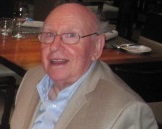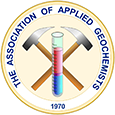Eion Cameron (1933-2014)
Eion Matheson Cameron 1933–2014

On May 30th of this year we lost a truly gifted and outstanding geochemist, pioneer, loyal friend, co-founder of our Association, at the time known as the Association of Exploration Geochemists (AEG) and now as the AAG, and founder of the Association’s journal, the Journal of Exploration Geochemistry (JGE): Eion M. Cameron.
Most of Eion’s long and illustrious career was spent at the Geological Survey of Canada (1966-2000) as both a research geochemist and as Head of the Applied Geochemistry Subdivision comprising some 32 scientists and technical staff. A major emphasis of Eion’s research was on the development, testing, and application of new and improved methods of detecting ore deposits both at surface and buried at depth. His accomplishments in this area are diverse. For example, he established lake sediment and water geochemistry as an effective mineral exploration tool in Canada’s north. Back in 1972, Eion carried out the first regional-scale geochemical survey in Canada, sampling lake sediments and waters over 93,000 km2 of the Northwest Territories in only six weeks using three helicopters and one float plane. Some of the discoveries, as a result of the survey include the Yava and Hackett River VMS deposits. This survey paved the way for Canada’s National Geochemical Reconnaissance Program (NGR). Also in the 1970s, he led the first GSC multi-disciplinary multi-agency project – Uranium Exploration in the Athabasca Basin.
Through his extensive research globally on the genesis of different mineral deposit types, Eion developed new rock geochemical techniques for locating lode gold, porphyry copper, and VMS/SEDEX base metal deposits. Other areas where Eion made major scientific advances are too numerous to mention here but he is highly acclaimed for his ground-breaking research on the sulphur cycle during the Archean-Proterozoic transition, which is critical to our understanding of ocean and atmosphere evolution. This seminal research, published in journals such as Nature, is still quoted extensively today and forms the basis of recent research on the sulphur cycle employing other isotopes, particularly 33S.
Eion’s contributions to the AEG/AAG continued from its founding up to his passing, not only in formal roles such as Editor-in-Chief (JGE), and later as the AAG’s Investment Manager, but in putting forth ideas to make AAG an active, stimulating, and highly useful organisation. Over the years, he was awarded all the AAG honours: the silver and gold medals, and honorary lifelong membership.
Eion, as Head of the Applied Geochemistry Section at GSC, hired me as a research chemist and I was delighted to join such a dynamic group at the GSC. He encouraged all of us to question, to think outside the box, to interact with scientists within and outside the GSC, and he gave us the opportunities to make real progress. For example, I had hardly arrived at GSC when he sent me down to Los Alamos to see and evaluate how the USA was planning its country-wide uranium reconnaissance programme and associated analytical procedures. Thanks to his leadership, our Geochemistry Group became a world leader in establishing this exploration methodology, alongside the US and British Geological Surveys. It was through his encouragement that we formed partnerships with such leading-edge companies as Barringer Research, Scintrex, and Sciex. He ensured we all communicated well and that we worked as a team.
Eion was an Adjunct Professor at the University of Ottawa (1983-2000) where he mentored 10 lucky graduate students. He enjoyed this enormously, mostly because of the collegial and stimulating environment in the Department of Earth Sciences. There he worked with and made a very good friend of Keiko Hattori. In his honour, Keiko is putting together a special issue of the successor journal to the JGE, GEEA. Eion knew this before he died and was very pleased.
One of the key factors that led to such success in Eion’s research is his early recognition that one needs to incorporate knowledge or technology from peripheral fields of study such as soil science, analytical chemistry, statistics, physics, oceanography, and microbiology. There are very few scientists who can or would have the foresight to delve into quite different fields to obtain this much more comprehensive view. I think another of Eion’s talents, demonstrated so well in all the publications from his ‘Deep Penetrating Geochemistry’ (he coined this phrase) research, was his ability to analyse, unravel, and describe, in fairly simple terms, processes of complex geochemical phenomena. His ca. 200 publications are superb, in their clarity, organisation, and brilliance. In the CAMIRO (Canadian Mining Industry Research Organisation) study that Eion led, where Stew Hamilton, Beth McClenaghan, and I worked with him as a team, he produced about 30 individual reports which were unique in that they could be read and understood by the highly trained geochemist and the field-oriented prospector alike. He extracted the essence of each piece of the puzzle to complete it. He was great fun to be within the field; his love for the science of geochemistry was infectious and stimulating.
Regardless of these gifts, Eion was very modest. I learned a lot from him, as did others. He never stopped learning; whether it was in science, business, financial investments, people, world affairs, cultural matters etc, his curiosity did not wane. Eion, we will miss you enormously and we are so grateful for your long-lasting legacy in exploration geochemistry.
Gwendy E.M. Hall
Ottawa.
